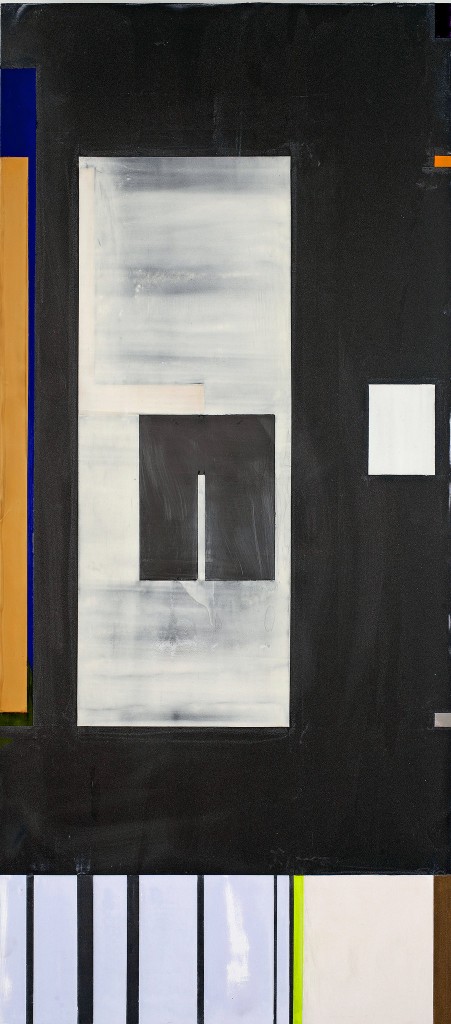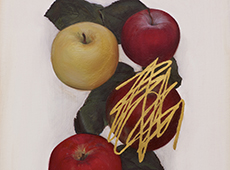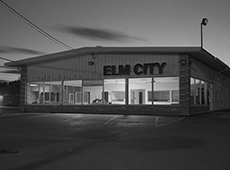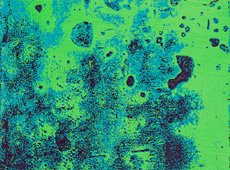“…[M]y work has always been concerned with a physical relationship with the body and how the body negotiates the world and receives a painting – through movement,” Joan Waltemath said in conversation with painter Gordon Moore.
Joan Waltemath’s paintings and drawings proceed from a deep understanding of how the body engages art—how their surfaces trigger our sense of touch; how their scale activates the edges of our peripheral sight. “[M]y work has always been concerned with a physical relationship with the body and how the body negotiates the world and receives a painting – through movement,” she said in conversation last week with painter Gordon Moore. The two artists sat down at Hionas Gallery, where Joan’s current exhibition, One does not negate the other, is showing through March 14.
The editors are grateful to Joan Waltemath, Gordon Moore and Peter Hionas for shaping this conversation for Tilted Arc.
![]()
Gordon Moore This exhibition, One does not negate the other, at Hionas Gallery seems to be “divided” into two distinct bodies of work—the more “formally” painted vertical “panels” and the spontaneous seeming unstretched canvas pieces.
One tends to draw a relationship between the two distinct formats in the show and the title you have given it; one does not negate the other. I’m curious if you see a relationship between the title and a theme that interests you? Are you trying to say something here, are you making a statement?
Joan Waltemath Ultimately, yes, but it’s kind of funny how it came about because the first thing I knew about this show was the title. I was in a lecture by Lisa Beck and in talking about her work, she mentioned that, well, one thing does not necessarily negate the other. So I wrote that down and afterwards I said to her, “I just got the title for my next exhibition from your talk.” She laughed and said, “Did I say that?”
I told Peter [Hionas] the title and then some weeks later we met and started going over work to figure out the installation. When it came together it all seemed to make sense. So things evolved naturally without any conscious effort to make a statement. When I chose the title I was thinking about a show I did in 1994 where I hung some big drawings that revealed how the mathematical structure in my work is laid out, together with some paintings that were derived from that grid matrix. I thought that in exhibiting those works together people would be interested in what the relationship was between them. Instead, people seemed compelled to choose one kind of work or the other, telling me they liked either the drawings or the paintings better, even the reviewers. At the time, I couldn’t really understand how the complexity of their interrelationships wasn’t more interesting than the either/or option.
© Joan Waltemath,
Courtesy of Hionas Gallery. Click to enlarge.
GM There is an implication in the title that in the minds of some people one would negate the other.
JW Yes, that’s implicit.
GM Where do you think that comes from?
JW I am not sure. It’s really mystifying. It mystified me back in the 90’s but when I ended up, really at Peter’s suggestion, putting in these two different bodies of work, I thought, well, this title I found will help people not to compare, not to say “Oh, I like this better than this.”
GM Right!
JW And rather have a chance to see an indication of a relation. I don’t know if the either/or option is something that is inherently American; it mystifies me since it is not the way I think. I’m always looking for relations.
GM I think that we seem to be at time when one thing has to be dominant, or people tend to look at things as not wanting to see two possibilities, but one solution. There is one solution to a specific structural issue or a specific theme, one thing. Painting has to be – for years and years I remember hearing this very often through art school – that painting has to be about one thing. So the idea of having a show where there are two distinctly though related, two distinctly different directions is probably very confusing for people – or problematic I should say.
JW While there’s no doubt it’s problematic, I don’t necessarily see the different directions. The interests in these works are similar, but the means and the materials are very different. Many of these paintings took 3, 4, 5 years, not that I worked all that time on them, believe me, but just the drying time for the oil, the process – it all takes its own time. Then the canvas works, they are part of another project I am working on, scraps from these large canvas pieces I’m sewing out in the Midwest. And they are constructed from remnants lying around that just happen to have the same dimension. They are made in about 5 minutes from this simple idea that the dimensions coincide; both use proportion and scale to address the body.
GM Do you always tend to work vertically? If so what associational significance would you attach to that?
JW Well, verticality can set up a one to one relationship to your body when you are standing in front of it. I’ve done horizontal works, and also squares, but since these works are initially focused on getting a recognition of the body to occur, the vertical format is critical.
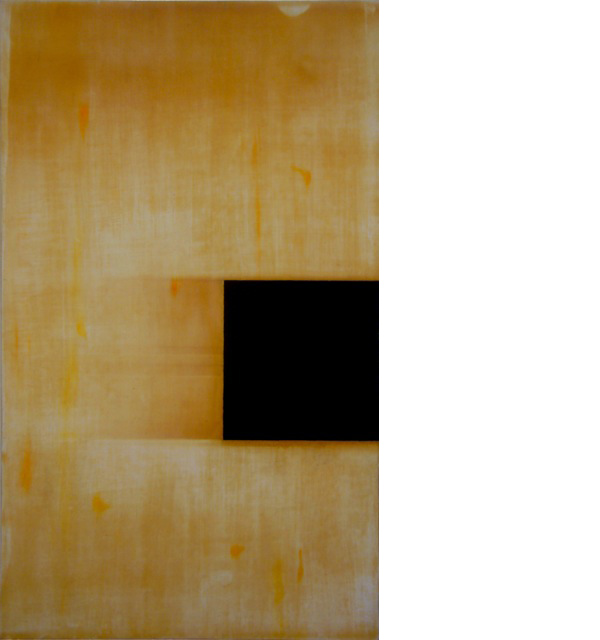
© Joan Waltemath.
Courtesy of Hionas Gallery.
GM Abstract painting seems to exist at a time now when there is an enormous trend in art towards the pop and the immediate pay-off of a punch line, or if I may be so prosaic, a cheap thrill. There is a deliberate construct in your work that runs very much in opposition to that, that forces one to slow down in order to absorb the logic of your decisions and the depth of your space. Could you talk about how do you feel you “locate” yourself in the current art environment? That’s a tricky question.
JW That’s a difficult question, but I really like what you said about my work slowing you down because I feel like that’s what I need from it. I am more at home when things aren’t going too fast. It is difficult to locate yourself in any milieu because you only have your subjective perspective on events.
GM Things have developed so quickly in respect to technology’s influence on everything we do, and certainly its influence on art that, for those of us who have been making paintings for a long time, the speed with which things are coming at us is such that I often think myself that I am personally outside of the current environment, that everything that I do is really based on my learning, my life experience from an entirely different era.
JW Yes, I felt that when I looked at your work, that’s why I wrote about the 50’s and a cohesive sense of design then, but I question this idea that every artist’s work should resonate with their own time. It’s a notion that I think took a turn in the 80’s with Buchloh’s position that painting was a medium that couldn’t negotiate the particular time we are living in now. This idea about art has not always prevailed and I don’t think it will always prevail. If we look around and see what inspires us, well, it wasn’t all made yesterday and today.
GM When I look at your work, the attraction for me is that there is an underlying aesthetic language in what you are doing. I think that an awful lot of art that I look at now doesn’t want to address, and completely avoids, what I would refer to as an aesthetic language. It’s either narrative or it’s about personal problems, personal life situations, which can be interesting, but I would not consider it to be necessarily aesthetically successful like I think your work is, in that I think that is the language that you are working with.
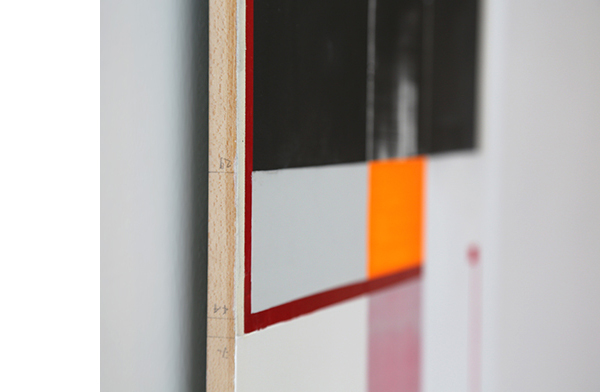
© Joan Waltemath. Detail from Hionas Gallery installation. Courtesy of Hionas Gallery.
JW Yes, I am working through a visual language so you see this and you see that. The cumulative experiences that you have visually add up to how it’s affecting you, the kind of experience it can give you.
GM But for me, they all have to be strained through an aesthetic sense, an aesthetic logic, an aesthetic language in order for them to be successful as art. I think it was Leo Steinberg who said, “whatever else it may be about, all art has got to be about art.”
JW About being art.
GM About itself, it has to be about itself, but I look at your work I think your work succeeds so well because it is art that is about an aesthetic language of art. Walking through this show, I’m taken with your consistent structural obsession with the right angle, which I subconsciously associate with the post and lintel in architecture. Knowing that you have also taught on architecture at Cooper Union, do you feel architectural concepts or principals are thematically present in your work?
JW Yes, certainly in some sense architecture permeates everything I do. When I was about 15 my mother took me to Rome. I remember an autumn day where the light was crisp and strong, stepping into the Pantheon, leaves were blowing on the opposite side and light poured through the oculus. The sensation of that void touched my body and I felt how it moved me to move in a more precise and careful way. It wasn’t really until I left the architecture school at Cooper that it finally crystalized for me how the body is the subject of architecture, but that is certainly something we worked on in architectonics the whole time I taught there. And that was probably the common ground I shared with the architects, because my work has always been concerned with a physical relationship with the body and how the body negotiates the world and receives a painting – through movement.
“…my work has always been concerned with a physical relationship with the body and how the body negotiates the world and receives a painting – through movement.”
GM Not long ago you had a very handsome group of vertical pieces on view at Schema Projects in Brooklyn, which were done on mylar and left unframed. Do you find that the use of differing materials affects the CONTENT of your work?
JW It allows me to articulate things in different ways. The density of those materials and process had a lot to do with my sense of reaching through time to the Dinwoody’s, and at the same time their sparkling presence now.

© Joan Waltemath,
GM Your use of white in the work in this show as well as your “linear” color elements and tabs occasionally puts me in mind of the late Alan Uglow, who was a wonderful artist. I knew Alan myself and I know that you knew Alan and lived close to him on the Bowery. Do you feel an occasional affinity with his work?
JW I would say it’s more than occasional. For me Alan was one of the most important painters I’ve met in New York, and we went back to showing at the Stark Gallery on Broadway and then in Chelsea in the 90’s and 2000’s, so I was able to show my work a couple of times with his. At the end of his life I went to visit him to write a piece. As I was sitting in his studio I realized that the light coming through his window on the Bowery was the same light I had painted in all these years, and that is a very particular light. So I called the piece “Sharing the light.” I saw Alan as an incredible master of materials. His ability to put down a surface showed a complete control over the viscosity of the paint, how he mixed his paints, his timing – he was masterful. He kept me in awe.
GM All true! As an artist who also has a considerable exposure as an interviewer and writer on other artists I’m curious as to how you view the process of writing about art and aesthetics influencing your own art and vise versa?
JW It’s funny when you sent me this question, the first thing I understood was, “how do you keep these two things separate,” and then I read it again and I realized you were asking me something different, quite the opposite actually.
GM What moved you to start writing about art?
JW There were a couple of things that were important to my starting to write about art. Teaching at Cooper, where I gave a two hour lecture about art to the first year architecture students, I would write out my lectures every week and that generated about 5 pages. This went on for 15 years, so at some point I thought, “I have to find a way to expand my audience.” Also, as I was reading the kind of criticism that was coming out then in the magazines that were around the galleries and in the glossies in 97, 98, 99, I felt that people were not talking about what was important in the work that I was seeing. Raphael Rubinstein articulated it most clearly a bit later in “A Quiet Crisis” (2003).
I had these complete other thoughts and realizations about work that I found no one else was addressing. I talked to other artists realized it would be important to share the kinds of things I was getting from works by reading the formal language that I had clarified for myself working in the architecture school. I met Phong Bui about that time and he invited me to start working with the Rail. All those things came together around 2000. I started with interviews and then the first piece I actually wrote was a piece on Agnes Martin when she had a show a Dia Beacon that coincided with a show at Pace Gallery. I looked at the paintings and I saw how she had carefully incised these lines though the paint with some kind of very sharp tool. There were little burrs on the edge of the paint that were so miniscule and then sometimes at the end of the line there was a little spiral of curled up paint that had been carved out through the incising. It was so beautiful. When I saw that I said to myself, “This is the last exhibition she will do in her lifetime;” the burrs she’s leaving are so fragile they’re not going to be here very long and she’s telling us that is where she is. I wrote that at the very end of the review, in a way that if you were astute you might understand what I meant.
GM Do you think that your writing has influenced your own art in a way?
JW Writing about art is from the outside, it is very much about how I can articulate an experience a work is giving me, how I read the formal language I discover in the piece while I am looking at it. When I wrote about your work I had no idea what I would say when I went in to look at it. I mostly sit with a pen and paper and write what comes into my mind as I’m looking; I start writing and let it flow out of me. I keep going as long as the work continues to unfold for me, so in this way I discover things. At the end I try to pull it together into a coherent form.
One of the big pleasures about writing about other people’s work is that I get to different kinds of understandings than I would otherwise. So, that is a big impetus to writing. Now I have been writing long enough that I can look at something and tell, oh, this work will take me on a kind of interesting journey and that makes me want to come back and write about it. Where with other work, if it’s a momentary thing and then its over and you don’t need to spend hours sitting there.
GM Do you think teaching has made you a better artist?
JW Certainly.
GM I am very much in agreement with that.
JW You have to challenge yourself the same way you challenge your students, otherwise you have no veracity when you are standing in front of them. They know this very well.
GM Yes, it is very hypocritical to expect them to reach a level that you can’t reach yourself.
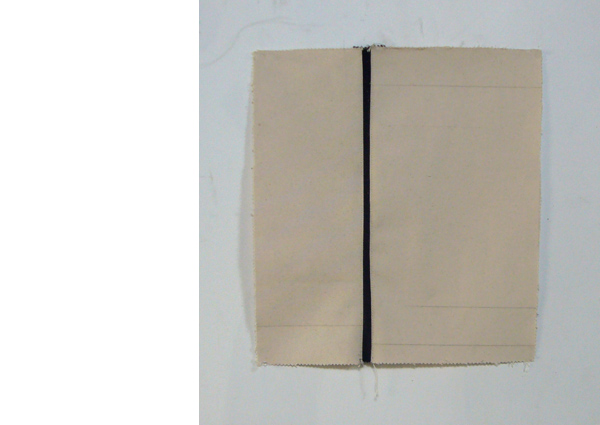
© Joan Waltemath,
15 1/2” x 16 3/4.” Courtesy of Hionas Gallery.
JW In fact, I think these sewn pieces came out of going back to teach painting and pushing painting students to go outside of their preconceived limits. While I was teaching in architecture, the way I would make my paintings and still do to a large degree, is, that I would build them up in layers. It is very much a constructive process. Most painters don’t see painting as building up something. My paintings are precise and the way I use materials doesn’t necessarily always reveal paint’s fluidity; some painters see painting just in terms of the aspect of its fluidity and how one forms that into a sentence.
GM I see, however, there is what I like to refer to as a visual dialogue, an interior dialogue going on inside your work, one area in a sense speaking to another by smearing paint and or marking wet paint in certain areas. Having that, in a sense, have a conversation with more precise, obviously, highly resolved clean edges, you get what I call a very interesting visual dialogue going on. The longer you look at the painting, it seems to enrich the visual experience. I’m wondering if that always happens spontaneously, intuitively, or if you have some kind of predetermined idea when you approach each piece, what it is going to end up looking like.
JW No, not at all. I mean I work from drawings, so in the drawings I lay out some configurations, but they change a lot while I’m working on them just because I’m always responding to what happens. I can’t know what they will look like. In fact, with this show, I didn’t know what it would look like until it was hung.
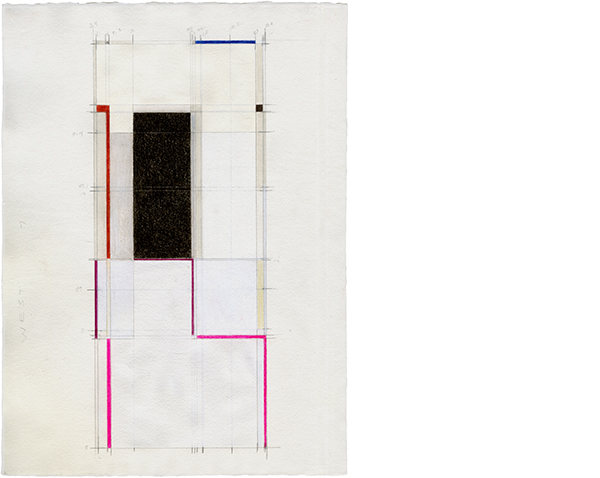
© Joan Waltemath,
GM But you start out with an idea?
JW I start out with a configuration of elements. So I have a grid I’ve chosen to work on, I put some elements into that grid and I work within the confines of that grid. The panels are custom made to the dimensions of the grid, the grid is laid out on the panel, so that has already determined a lot. Then within that framework I can do anything.
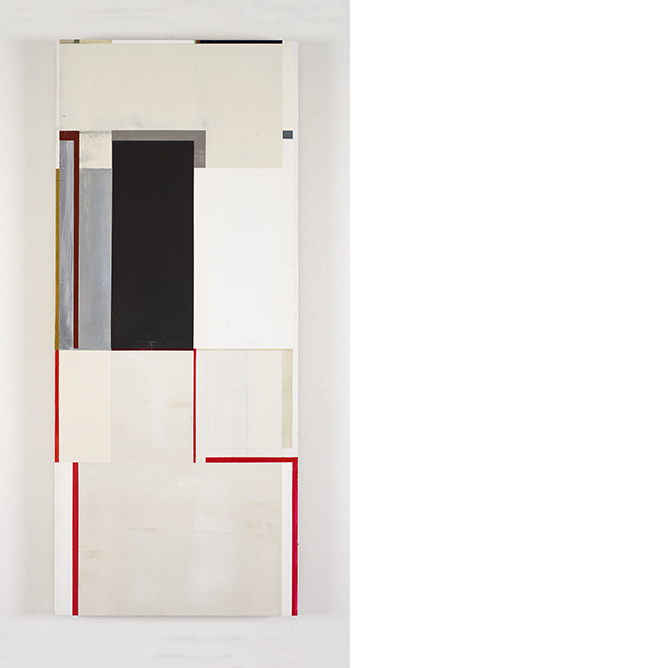
© Joan Waltemath,
GM So you use the grid as a kind of system to refer to?
JW It’s more like a matrix.
GM Oh, okay.
JW Or an underlying structure, I don’t create additional divisions that are not in the grid.
GM There are no drawings in this show, do you draw a lot?
JW I can easily imagine that for every painting I make there are about 25 – 30 drawings, so yes. I have drawings in wet and dry media; also these canvas pieces are almost like drawings even though they are not prep drawings for anything.
GM As I walked through this show I intuitively responded to the canvas pieces as being ‘drawing with canvas,’ that was essentially how I saw them. That is kind of an inventive thing in itself. I can’t think of anyone’s work that I have seen recently where I thought they were drawing with canvas. By stitching canvas together that way, you were actually just drawing – using it as a drawing material.
JW Jim Lee’s show is across the park at Nichelle Beauchene Gallery. He’s stitching canvas together, as well, but it’s very much painting.
GM That’s right. So, do algorithms play a conscious part in developing your content?
JW Yes, certainly. What is important in working with algorithms is how they allow different dimensions to get folded into a plane. I think all painters are ultimately interested in that because a plane with its 2 dimensions doesn’t have any depth. So the algorithms provide a very interesting kind of structure that you can open up and that allows you to visualize the relationship of coordinates spatially. I think for people who can stand in front of my paintings for a while, they can feel those dimensions starting to open up. The algorithms don’t do that alone and I don’t do that alone; I’m using them to help me to start enfolding other dimensions that then slowly unfold over time.
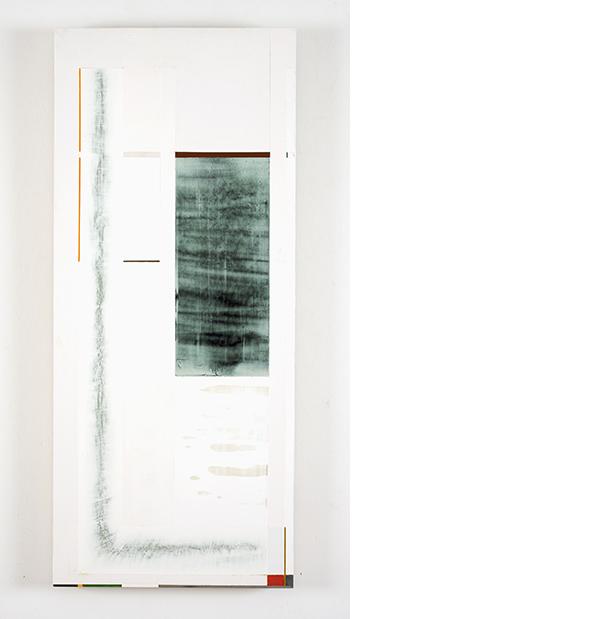
© Joan Waltemath,
Courtesy of Hionas Gallery.
My ideal is the person who has been living with one of my paintings for some years and then one day sees something that had never been there before. They are still seeing, they are still actually seeing it and it doesn’t just become part of their furniture.
GM I find that is how I respond to your work. I think that is what your work really is all about for me. Maybe even more that Alan Uglow’s work, which has a little bit more of a punch, a direct, simple clear impact. I’m drawn into your work slower, I think, than Alan’s work, which reads to me quicker. I think in part because his association with minimalism was so strong. I don’t know if Alan considered himself a minimalist. Sometimes you don’t know whether or not any of the minimalists considered themselves minimalists, but I certainly considered Alan to be in that genre.
JW I remember going over to Alan’s after his father died. He had come back from England with all these photographs of himself as a child. As I was looking at them, the doors, the houses, the yards, the chairs, the cars, his toys I realized that it all felt like Alan’s work. I suddenly understood the sensibility we get from his paintings was all part of the world he grew up in the 40’s and 50’s. That was so shocking because here the association with minimalism was inevitable, but I think for him it was rooted in something else. I remarked on that to him when I was there, but I could see he wasn’t concerned with it like I was, though he said, “yea, yea.”
GM He was probably just so close to it…
JW That makes sense.
GM If algorithms are a system, do you feel your interest in them is a lack of integrity? I am thinking of Nietzsche’s statement: “The will to a system is a lack of integrity.” [Laughs] How would you respond to that?
JW This is good, I like that, Gordon.
GM Yes?
JW Well, the system part is where it breaks down for me because there is no real system. Blake also said, “I must Create a System, or be enslav’d by another Man’s” just to push back a bit on Nietzsche.
GM Very good, yes.
JW It’s more like a tool. Someone else could use color to enfold dimensions. I just happen to have a really mathematical mind and I feel at home with numbers. Some people have very literary minds.
GM I’m very much fascinated by the fact that you have your hand in both directions. You both write about art and you make art and do both very seriously. I think it comes through in your work. I see a mind that is really examining other people’s work in your own work, looking very, very deeply into decisions other people make, when you make your own work. That for me is a strength in what you do.
JW The quality of the kind of decisions I make is important to me. As I’m working, too, I think a lot about the nature of the decision making that goes on – how spontaneous can it be?
For the painting in the front, Oaxaca Blue, I planned out a whole different thing, and then I put it down and it looked horrible, so I had to quickly move it somewhere else.
During the early 80’s I worked with a film group in my loft making Super 8 films and video. I learned so much – the ability to work with other people and be spontaneous making group decisions within an established framework was something I took from my filmmaking experience back into painting. I feel like the ability to work within a structure that’s coherent and maintain spontaneity at every turn is essential for art making. You need the lightness of spontaneity, but structure is grounding.
“I feel like the ability to work within a structure that’s coherent and maintain spontaneity at every turn is essential for art making. You need the lightness of spontaneity, but structure is grounding.”
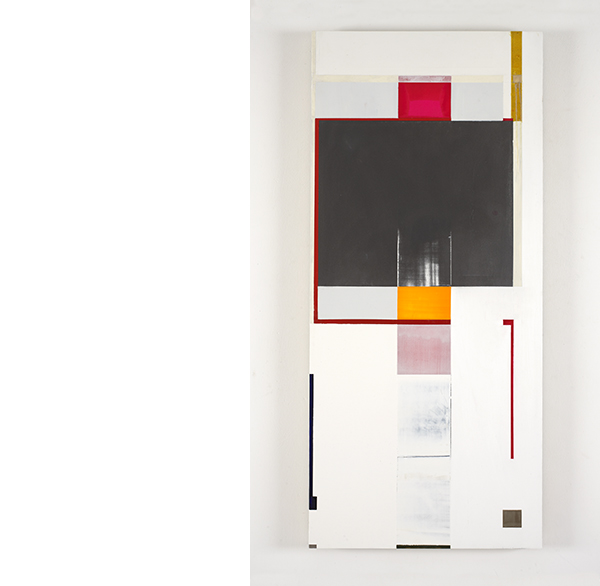
© Joan Waltemath,
Courtesy of Hionas Gallery.
GM Absolutely! You always have to be open to the accident or the incident that happens in any occasion.
JW That’s the hardest thing in teaching, to try to get students see what they are actually doing as opposed what they think they wanted. It’s hard because when you have your mind set on something, you can only see what you are doing in terms of how close it gets to your mindset. We are always reminded when someone comes in and is inspired by something we are so desperately trying to get to go somewhere else.
GM Or are inspired by something you don’t even really regard as being that important.
JW Funny, no?
GM As one draws closer to your painting in this show it becomes very obvious that each work has gone through many very deliberate and specifically conscious changes both in terms of color and structure. How do you arrive at a place in your painting where you feel a sense of completion? Do you feel that “end point” is reached through reason or intuition? Or is it a dialogue of both, one influencing the other?
JW The way I work developed out of living in New York and how my working time here gets fragmented. So, I work on my pieces little bits at a time. I usually have at least 20 pieces underway in my studio, they evolve in tandem, all hanging about all over the walls talking to one another. I’m looking at them for longer periods of time, so I figure out what the next move could be, and then if I remember it when the painting is dry, I can try it. People often think my paintings are labor intensive, but actually they are time intensive, which is a bit different. Finally, all these fragmented bits of time start to coalesce and take on a character of being something as it all falls into sync. That is the end point.
GM Hey, that is a good note to end on.
Joan Waltemath lives and works in New York City. Her works in oil on panel, graphite on mylar, mixed media on paper and sewn canvas employ materials for their connotative properties as well as their experiential potential. Her abstract paintings focus on constructing spatial voids using harmonic progressions and non-traditional, reflective pigments in oils. Her drawings on mylar and paper in diverse wet and dry materials have long been at the root of her artistic practice, serving as a means to map the development of her thinking. Shown in New York, Miami, Portland, Baltimore, London, Basel and Cologne, her work is in the collections of the Harvard University Art Museums, the National Gallery of Art, the Hammer Museum and the Museum of Modern Art among others. She is the recipient of numerous grants including Creative Capital, and the Pollack-Krasner award. She has written extensively on art and has served as an editor-at-large of the Brooklyn Rail since 2001. She taught at the IS Chanin School of Architecture of the Cooper Union from 1997 to 2010 and at Princeton University. She is currently the Director of MICA’s LeRoy E. Hoffberger School of Painting.
Born in Cherokee, Iowa, Gordon Moore received his undergraduate degree from the University of Washington, Seattle in 1970 and his MFA from Yale University in 1972. Soon after completing his graduate studies, Moore received his first solo exhibition at Cuningham Ward in New York. He has received numerous awards and grants including the National Endowment for the Arts-Visual Artists Fellowship, the Louis Comfort Tiffany Foundation Award in Painting, the Adolph and Ester Gottlieb Foundation Award in Painting, New York Foundation for the Arts Fellowship, the Academy Award in Art from the American Academy of Arts and Letters and the Pollock Krasner Foundation Grant. Moore’s work can be seen in the collections of the Museum of Fine Arts, Boston, MA; Yale University Art Gallery, New Haven, CT; Baltimore Museum of Art, Baltimore, MD; General Electric Corporation, East Cleveland, OH and the Krannert Art Museum and Kinkead Pavilion, Champaign, IL.
Editor’s Notes:
View One does not negate the other at Hionas Gallery, up through March 14, 2015.
Read an interview with Joan in BOMB Magazine with Mary Jones.
Read Joan’s piece about Alan Uglow in The Brooklyn Rail, “Sharing the Light: Alan Uglow’s Generous Economy of Beauty.”
Read all of her pieces for The Brooklyn Rail.
View more of Joan’s work at her website, joanwaltemath.net.
Read Gordon Moore’s Tilted Arc conversations: Dimensionality, Ground, Photography & Drawing, Process, and Enigma.
View his most recent show at Betty Cunningham Gallery. Watch Gordon speak about his work and process.
Read Raphael Rubinstein’s “A Quiet Crisis.”
Subscribe to Tilted Arc
If you like this story, please consider subscribing. We are sticklers for privacy.
We will never sell or share your e-mail address.

